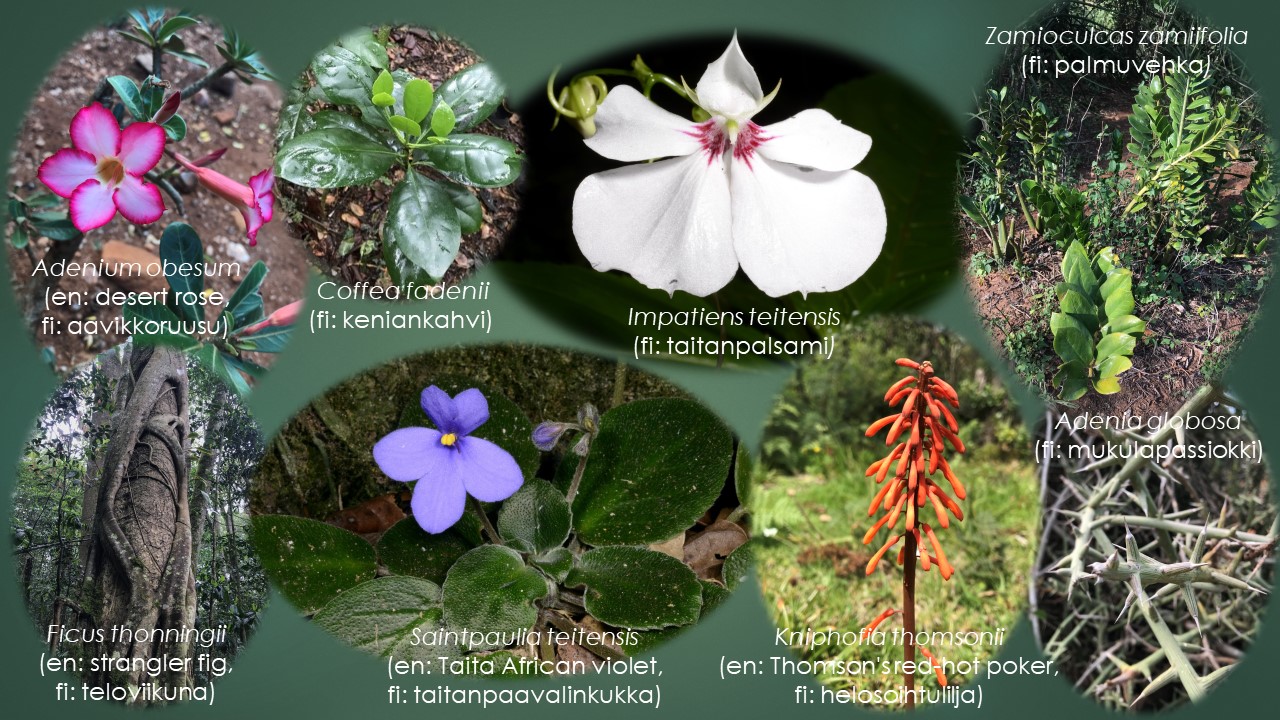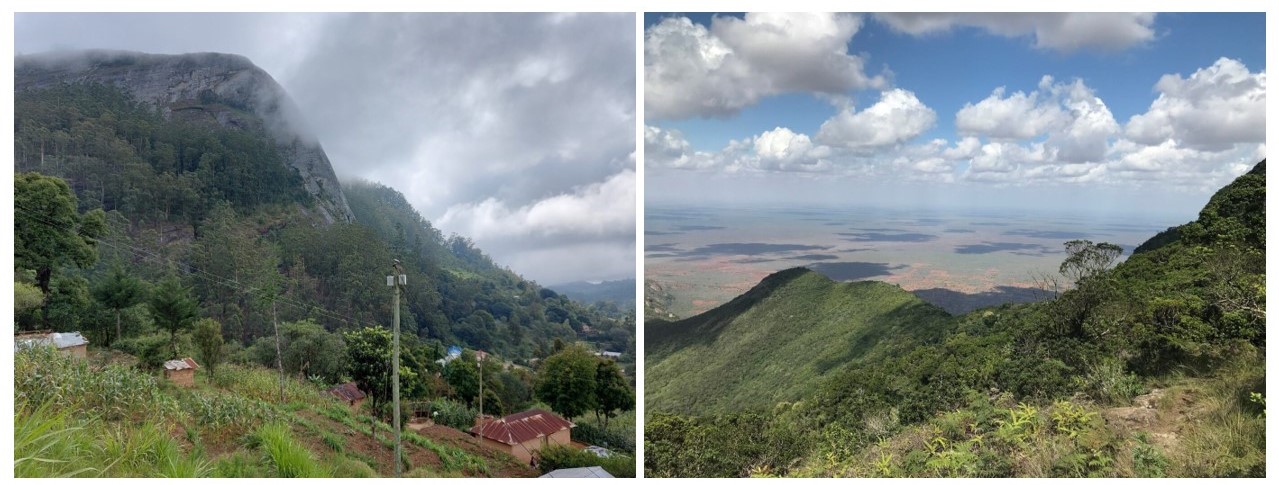Ecology field course in Kenya
At the hottest hour, we stop at a cliff for a lunch break. It’s January in Ngangao, one of the few protected montane forests remaining in Eastern Kenya. Everyone finds a rocky seat and starts digging their backbacks for lunchboxes. I have brought fresh avocados, passion fruits and mangos from the market place. This time we found both sweet and sour varieties of passion fruit. Someone asks a half-question about nature and our Professor, Jouko Rikkinen, seizes the moment and starts lecturing about lichens and lichen symbionts. I listen, but mostly for the beauty of it all. View behind him stretches hundreds of kilometers to the lowlands. Wind is soft and Ken, Darius and Mwadime are asleep and snore slowly. Swallows, such as barn swallows (Hirundo rustica), greet us with their spectacular airshow. I wonder if they are the same to which I bid farewell a couple of months back in Finland.

Jambo! I’m Maria Reiman, a Master’s student at the Master’s Programme in Integrative Plant Sciences. With the help of HiLIFE Trainee Conference Grant I was able to participate in Flora and vegetation of East Africa –field course (IPS-175) in Kenya in January 2023. In this blogpost, I’m going to share some of my key learnings as well as plant treasures of Taita Hills.
The course was organized by the University of Helsinki’s Faculty of Biological and Environmental Sciences, and our teachers on the field were Prof. Jouko Rikkinen, Mr. Mwadime Mjomba and Mr. Darius Kimuzi. The aim of the course is to learn about plant biodiversity in the area as well as climatic and environmental factors determining it. The Taita Research Station, established by the University of Helsinki in 2011, served as a base to our field course. It is located at Taita Hills in southeastern Kenya, in the village of Wundanyi. The area has attracted many scientists from different fields but especially biologists and geographers as it is a very unique area biogeographically. Taita Hills are like a miniature of East-Africa with an elevation range from 500 to 2200 meters and ecosystems including dry grasslands to moist montane rainforests.
Learning in the field
Nature was our classroom for the week. Every day, we would go to a different mountain, walk up the slopes and wonder at everything around us. Picture a group of students and teachers walking very slowly, taking pictures, squatting and pointing at something. Our guide and driver Ken was always sighing like “I just can’t with these botanists…”.
Mountains are an exception to Africa’s very flat general landscape. This goes back to 100 million years ago when the ancient supercontinent, Gondwana, broke up. South America, Antarctica, Madagascar, Australia and India separated but the remaining middle part – Africa – didn’t go through massive mountain formations unlike the other continents. However, these movements formed Eastern Arc –mountain chain of Kenya and Tanzania. Taita Hills are the northernmost mountain range of Eastern Arc.

Taita Hills are one of the most important biodiversity hotspots of Africa. They are known for their moist forests and unique flora and fauna. The moist rainforests support high diversity of life. One explanation to this is that because water and temperature are not limiting factors, species can focus on competition with other species, leading to speciation and evolution. For example, in dry and only seasonally warm Finnish forests, there are usually only a few dominant tree species but Kenyan rainforests host tens or even close to a hundred tree species. During the field course, I learned at least 176 new species (or if not learned then at least took notes and pictures).
Rainforest’s canopy is multi-storey as plants compete for light. Taita Hills used to be a vast rainforest area but due to changing climate and its consequence, anthropogenic pressure, there are only a dozen forest patches left. Most are the size of a few hectares and some are 70-190 hectares. Many species have evolved in Taita Hills and are thus so called endemic species. The mountain peaks have acted like islands and some species have their own subspecies for every mountain peak due to diversification.

People’s livelihoods, biodiversity and ecosystem functioning are interdependent
Taita Hills, like all mountains, provide many vital ecosystem services for humans. One of the most important is water. Water’s journey to Taita begins 200 km eastwards from The Indian Ocean. Moist trade winds flow towards Taita and condense to water when they hit the eastern forested slopes of Taita. In this sense, the mountains act as water towers. Montane forests capture and provide water for vast areas and households far below in the lowlands.
Deforestation of montane forests and climate change have led to decreased water security in the area. Clear-cutted forest land doesn’t catch water as well as montane forests and their vegetation would and ‘water tower effect’ is lost. Rains have become unpredictable and sparse. This has devastating consequences for humans and wildlife. When humans struggle, questionable methods are used to meet the living costs. Even more forest is cut to get livelihood from selling timber and firewood. This leads to a vicious circle where water is even scarcer. However, local authorities are taking action to stop the deforestation of remaining forests. These include e.g. guidance of agroforestry methods and reforestation with native tree species.
In Taita Hills, there are some reference areas like Mount Kasigau (1000 m up to 1600m), previously inhabited higher at the hills but people moved downhill when the issue with water arose. Currently, only the lower hills of Mount Kasigau are inhabited and there are no plantations. Mount Vuria (500 m up to 2200m) however, is largely under human pressure and deforestation is ongoing. Optimally, Mount Vuria would look like Mount Kasigau. On our hike at Mount Vuria we witnessed forest cutting and many invasive tree species. Invasive tree species and their plantations are a huge problem in East Africa. For example, Eucalyptus-plantations cause many wildfires because their bark is very fire-prone while the tree itself is very fire-resistant.

Native and biodiverse montane forests maintain functioning ecosystems which in turn mean secured water supply and livelihoods for people. Nowadays, people are moving downhill to the lowlands which is good in terms of water security. However, this has increased the number of human-wildlife -conflicts when residential areas and wildlife territories overlap. Elephants and baboons can destroy crops but they are undeniably vital for lowland ecosystems and their ecosystem services. As always, the co-existence of humans and the rest of the natural world is complicated but the search for compromise is a necessity.
The joy and anger of finding things out
As botanists, we were of course very interested in individual plant species of Taita Hills. In addition, we gained a lot of insight about ecosystem dynamics and societies of the tropics that could never be learned from the books. We discovered new species, ecosystems and phenomena every day. The more we learned and understood, the wider our view of the natural world got. Access to this type of knowledge is a privilege that correspondingly means responsibility.
Developed countries such as Finland, produce most of the greenhouse gases yet the consequences are currently mostly suffered in the developing countries such as Kenya. Developed countries must learn to live within the planetary boundaries e.g. by carrying their responsibility, reducing emissions and stopping overconsumption. Actors of the developed countries – states, companies and inhabitants – have the resources for these actions and there aren’t any acceptable excuses for not acting. Liveable future for all lifeforms of the Earth is secured and determined only by actions done in this decade (IPCC 2023).
Getting a wider perspective of global change, such as climate change and biodiversity loss, meant anger caused by injustice, lack of actions and already unstoppable consequences such as deaths of people and endemic species. We are devastated by drought and deforestation in the area, which were largely caused by climate change or its consequential human pressure. Defending and fighting for the beautiful but threatened biodiversity and ecosystems of Taita Hills are also our duty. Our realities are linked and swallows migrating from their overwintering sites in Kenya to their breeding grounds in Finland are an evident symbol of that.
_________________________________________________________
Big thanks to station staff, teachers, faculty, steering board and everybody who made this field course possible. We students really appreciate this as we know that field courses are constantly threatened with tightening budgets. Thank you for understanding that skilled biologists are made in the field, not classrooms!
PS:
- Fellow students and dear friends of mine have also written HiLIFE-blogposts about Kenya. Gabriela Lemoine wrote a post about her experiences with more reflection e.g. about native and invasive species as well as our teacher’s, Mr. Darius Kimuzi’s, innovative agroforest farm. Lola Fernández Multigner took part in Human-Wildlife Conflicts in East Africa –field course (EEB-306) organized also by the University of Helsinki. She describes the complicated relationship between elephants and humans in this post.
- Kaisaniemi Botanic Garden has many East African plants. For example, you can find Saintpaulia teitensis in the African Violet Room, Ficus thonningii in the Dry Forest Room and Coffea fadenii in the Rainforest House! Pictures of these are earlier in the text.
- Water’s Journey, a documentary (2022) about Taita Hills can be found in Yle Areena. Beautiful nature, daily life and current topics are displayed magnificently. Watch Water’s Journey here.
References
EAMCEF. (12.8.2014). Eastern Arc Mountains. The Eastern Arc Mountains Conservation Endowment Fund (EAMCEF). [Webpage]. Available: https://eamcef.wordpress.com/2014/08/12/eastern-arc-mountains/
IPCC. (2023). Climate Change 2023: Synthesis Report. Contribution of Working Groups I, II and III to the Sixth Assessment Report of the Intergovernmental Panel on Climate Change [Core Writing Team, H. Lee and J. Romero (eds.)]. IPCC, Geneva, Switzerland, pp. 35-115, doi: 10.59327/IPCC/AR6-9789291691647
Kaasalainen, Ulla. (No date). Taita Hills and Mt. Kasigau. Lichens from East Africa and elsewhere. [Blog]. Available: https://lichens.academy/taita-hills-and-mt-kasigau-kenya/
Laine, Toni. (2022). Water’s Journey. [Documentary Film]. Helsinki: Wild Heart Productions Oy. Available: https://areena.yle.fi/1-61218224
Niemelä, T. (2011). Vihreä Afrikka: kasveja ja kasvillisuutta. Norrlinia; Vol. 23. Luonnontieteellinen keskusmuseon kasvimuseo.
